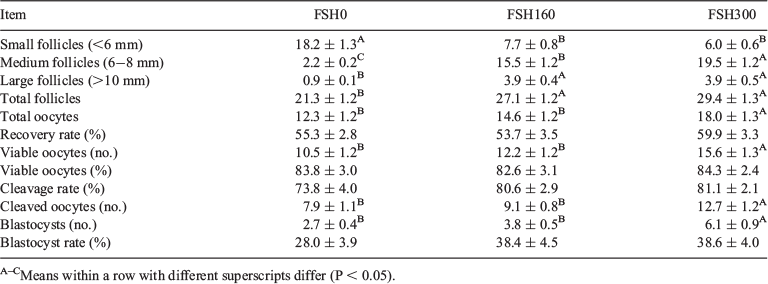135 Use and dose of porcine follicle-stimulating hormone for ovarian superstimulation prior to ovum pickup and in vitro embryo production in pregnant Holstein heifers
R. V. Sala A , L. C. Carrenho-Sala A , M. Fosado A , E. Peralta A , D. C. Pereira A , D. Moreno A , J. F. Moreno A and A. Garcia-Guerra BA ST Genetics, Deforest, Wisconsin, USA;
B Department of Animal Sciences, The Ohio State University, Columbus, OH, USA
Reproduction, Fertility and Development 31(1) 192-193 https://doi.org/10.1071/RDv31n1Ab135
Published online: 3 December 2018
Abstract
The benefit of superstimulation with exogenous FSH before ovum pickup for in vitro embryo production has been the subject of significant controversy. In addition, there is limited information on different dose regimens. Thus, the objective of the present study was to evaluate the effect of dose of porcine (p)-FSH during superstimulation before ovum pickup (OPU) on in vitro embryo production in pregnant heifers. Pregnant Holstein heifers (n = 36) were assigned to a complete 3 × 3 crossover design. Three treatment groups were evaluated as follows: p-FSH 0 mg (FSH0), p-FSH 160 mg (FSH160) and p-FSH 300 mg (FSH300). Three sessions of OPU were performed on each animal at 48, 62 and 76 days of gestation, with a washout interval between sessions of 14 days. Follicular wave emergence was synchronized by dominant follicle removal. Heifers in the FSH0 group received no further treatment, whereas the remaining groups received a total of 4 injections 12 h apart as follows: FSH160 (48.0, 42.7, 37.3 and 32.0 mg) or FSH300 (90.0, 80.0, 70.0 and 60.0 mg), beginning 36 h after dominant follicle removal. Ovum pickup was performed in all heifers 40 h after the last p-FSH injection. Heifers were subjected to OPU for oocyte recovery, and number of follicles was determined. Recovered oocytes were processed and in vitro embryo production performed. Differences between treatment groups were evaluated by generalized linear mixed models. Data are presented (Table 1) as mean ± standard error of the mean. There was no effect of days in gestation for any of the outcomes evaluated (P > 0.05). Follicle numbers at the time of oocyte recovery were different (P < 0.01) between groups. Heifers in the FSH300 group had a greater (P < 0.05) number of medium, large and total follicles than heifers in the FSH0 group, whereas heifers in the FSH160 were intermediate. Total number of recovered, viable and cleaved oocytes were greater (P < 0.01) in FSH300- than in FSH160- and FSH0-treated heifers. Cleavage rate and blastocyst development rate were not different (P > 0.10) between groups. The number of grade 1 and 2 blastocysts was greater in FSH300- than in FSH160- and FSH0-treated heifers (P < 0.03). In summary, the use of 300 mg of p-FSH before OPU in pregnant heifers increases the number of follicles, oocytes and blastocysts produced per heifer with no detrimental effect on oocyte competence.

|


